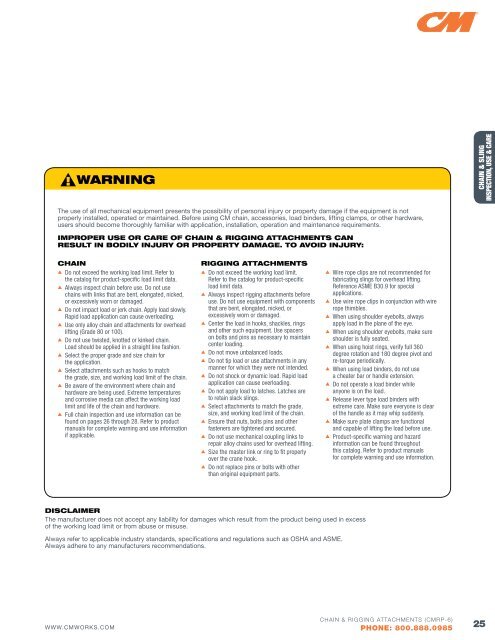zeqQT
zeqQT
zeqQT
Create successful ePaper yourself
Turn your PDF publications into a flip-book with our unique Google optimized e-Paper software.
CHAIN & SLING<br />
INSPECTION, USE & CARE<br />
The use of all mechanical equipment presents the possibility of personal injury or property damage if the equipment is not<br />
properly installed, operated or maintained. Before using CM chain, accessories, load binders, lifting clamps, or other hardware,<br />
users should become thoroughly familiar with application, installation, operation and maintenance requirements.<br />
IMPROPER USE OR CARE OF CHAIN & RIGGING ATTACHMENTS CAN<br />
RESULT IN BODILY INJURY OR PROPERTY DAMAGE. TO AVOID INJURY:<br />
CHAIN<br />
Do not exceed the working load limit. Refer to<br />
the catalog for product-specific load limit data.<br />
Always inspect chain before use. Do not use<br />
chains with links that are bent, elongated, nicked,<br />
or excessively worn or damaged.<br />
Do not impact load or jerk chain. Apply load slowly.<br />
Rapid load application can cause overloading.<br />
Use only alloy chain and attachments for overhead<br />
lifting (Grade 80 or 100).<br />
Do not use twisted, knotted or kinked chain.<br />
Load should be applied in a straight line fashion.<br />
Select the proper grade and size chain for<br />
the application.<br />
Select attachments such as hooks to match<br />
the grade, size, and working load limit of the chain.<br />
Be aware of the environment where chain and<br />
hardware are being used. Extreme temperatures<br />
and corrosive media can affect the working load<br />
limit and life of the chain and hardware.<br />
Full chain inspection and use information can be<br />
found on pages 26 through 28. Refer to product<br />
manuals for complete warning and use information<br />
if applicable.<br />
RIGGING ATTACHMENTS<br />
Do not exceed the working load limit.<br />
Refer to the catalog for product-specific<br />
load limit data.<br />
Always inspect rigging attachments before<br />
use. Do not use equipment with components<br />
that are bent, elongated, nicked, or<br />
excessively worn or damaged.<br />
Center the load in hooks, shackles, rings<br />
and other such equipment. Use spacers<br />
on bolts and pins as necessary to maintain<br />
center loading.<br />
Do not move unbalanced loads.<br />
Do not tip load or use attachments in any<br />
manner for which they were not intended.<br />
Do not shock or dynamic load. Rapid load<br />
application can cause overloading.<br />
Do not apply load to latches. Latches are<br />
to retain slack slings.<br />
Select attachments to match the grade,<br />
size, and working load limit of the chain.<br />
Ensure that nuts, bolts pins and other<br />
fasteners are tightened and secured.<br />
Do not use mechanical coupling links to<br />
repair alloy chains used for overhead lifting.<br />
Size the master link or ring to fit properly<br />
over the crane hook.<br />
Do not replace pins or bolts with other<br />
than original equipment parts.<br />
Wire rope clips are not recommended for<br />
fabricating slings for overhead lifting.<br />
Reference ASME B30.9 for special<br />
applications.<br />
Use wire rope clips in conjunction with wire<br />
rope thimbles.<br />
When using shoulder eyebolts, always<br />
apply load in the plane of the eye.<br />
When using shoulder eyebolts, make sure<br />
shoulder is fully seated.<br />
When using hoist rings, verify full 360<br />
degree rotation and 180 degree pivot and<br />
re-torque periodically.<br />
When using load binders, do not use<br />
a cheater bar or handle extension.<br />
Do not operate a load binder while<br />
anyone is on the load.<br />
Release lever type load binders with<br />
extreme care. Make sure everyone is clear<br />
of the handle as it may whip suddenly.<br />
Make sure plate clamps are functional<br />
and capable of lifting the load before use.<br />
Product-specific warning and hazard<br />
information can be found throughout<br />
this catalog. Refer to product manuals<br />
for complete warning and use information.<br />
DISCLAIMER<br />
The manufacturer does not accept any liability for damages which result from the product being used in excess<br />
of the working load limit or from abuse or misuse.<br />
Always refer to applicable industry standards, specifications and regulations such as OSHA and ASME.<br />
Always adhere to any manufacturers recommendations.<br />
WWW.CMWORKS.COM<br />
CHAIN & RIGGING ATTACHMENTS (CMRP-6)<br />
PHONE: 800.888.0985<br />
25


